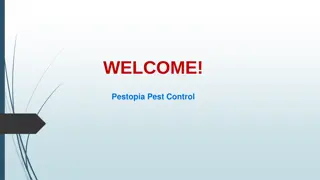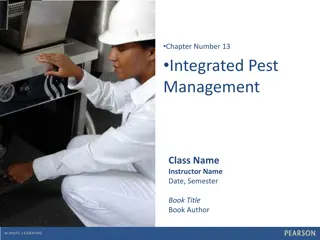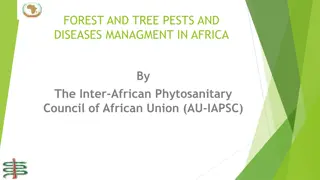Pest Management Strategies for Mesta Plant Pests in India
Discover effective pest management techniques for common pests, including the Mesta Hairy Caterpillar, Mesta Stem Weevil, and Mealy Bug, that infest malvaceous plants like bhendi and guava in India. Learn about the appearance, life cycle, symptoms, and management strategies to protect your crops.
Download Presentation

Please find below an Image/Link to download the presentation.
The content on the website is provided AS IS for your information and personal use only. It may not be sold, licensed, or shared on other websites without obtaining consent from the author. Download presentation by click this link. If you encounter any issues during the download, it is possible that the publisher has removed the file from their server.
E N D
Presentation Transcript
MESTA HAIRY CATERPILLAR Euproctis scintillans Lymantriidae: Lepidoptera APPEARANCE Moth is yellowish with a reddish line and spots on the edges. Larva has yellowish brown head and yellow dorsal stripe with a mid dorsal red stripe. There are tufts of black hairs dorsally on the first three abdominal segments. LIFE HSTORY Eggs are laid in masses on the undersurface of leaves. The egg period is 5-9 days. Eggs hatch into larvae and feed on foliage.
Larva pupates in a cocoon of hairs on the leaves or leaf folds. Pupal period lasts for 10-12 days. SYMPTOMS: Heavy defoliation MANAGEMENT Timely sowing at the onset of monsoons, foliar sprays with endosulfan 2 ml/l or methyl demeton 2 ml/l were effective.
MESTA STEM WEEVIL Alcidodes affaber Curculionidae: Coleoptera This insect is a common pest on malvaceous plants in India infesting bhendi,gogu, Bombax malabaricum, Althae rosea and Ficus bengalensis etc. The adult feed on leaf buds, petiols and tender terminal portion. However, serious damage is caused only by the grubs boring into stem and petioles and causing gall like swellings. Frass is found through holes made on stems. The infested plant gets stunted. Their flowers and fruiting get retarded considerably. A single plant may harbor as many as 12 grubs. This pest is active from September-December.
The grubs are parasitised by Aphrastofracon alcidophagus (Braconidae) and Zoridescopus spp (Ichneumonid).
MEALY BUG Meconellicoccus hirsutus Pseudococcidae: Hemiptera Besides mesta, it also attacks jute, grapevine and guava. Sac-like pink coloured females are covered by milky white waxy coating. Eggs are laid in masses. Upon hatching, crawlers move to succulent parts and suck sap resulting in symptoms like swelling on stem, shortened internodes, bunchy top formation as secondary branches arise. If growing tips are infested vertical growth is suppressed. Fibre snaps at point of infestation during retting.
Release of Cryptolaemus montronzieri when peak infestation is noticed in sep-oct and foliar spraying with methyl demeton 2ml/l or dimethoate 1.5ml/l is effective.
LEAFHOPPERS Amrasca biguttula biguttula Cicadellidae: Hemiptera APHID Aphis gossypii Aphididae: Hemiptera























